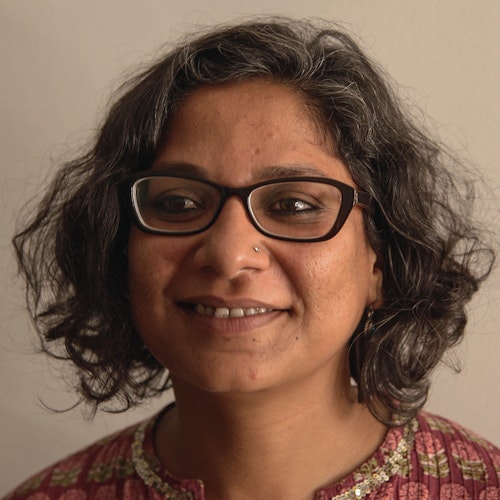Pay as you go: the birth of South Delhi’s {Khirkee17}
Aastha Chauhan
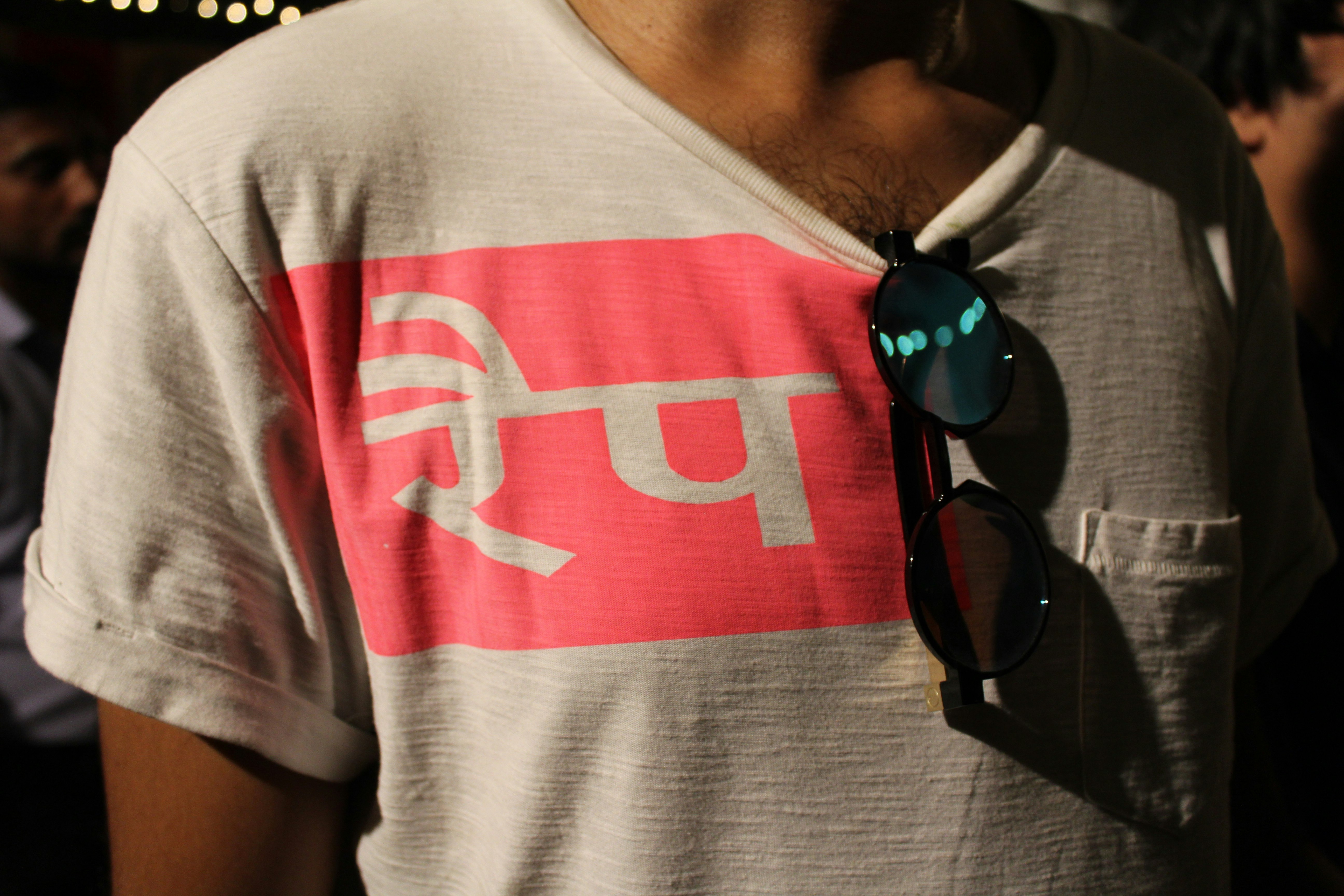
At the launch of the {Khirkee17} t-shirts with Delhi Sultanate; photo: Yemi Awosile.
It’s 2010. The Commonwealth Games have descended upon Delhi, a great opportunity for the city. Infrastructure, such as the efficient Delhi Metro, an unusable Commonwealth Games village, and several other roads and flyovers, has emerged within the capital city’s dense built environment. Several novel ways of stealing money from the government and swindle millions in corrupt deals are invented. One of the top ten scams of recent Indian history is born (and that’s saying something). The country is happy, or so it seems, wholeheartedly spending its taxpayer’s money on a sporting celebration defined by an association of nations whose common denominator is a Queen who stole from us for nearly two centuries. A few years prior, in anticipation of this grand celebration, the Delhi Development Authority auctioned nearly 54 acres of land to commercial developers. Here, today, on this land, sits the Saket District Complex, one of Delhi’s largest commercial and retail hubs comprising five functioning shopping malls, three hotels, fountains, air-conditioning and the rights to reserve admission.
It is within this backdrop of construction that we find our protagonists living and working, just across the street, in the neighbourhood of Khirkee Extension in South Delhi. A lower middle class, mixed use neighbourhood, Khirkee is home to migrants from India and numerous other countries including Afghanistan, Somalia, Uganda, Cameroon, Nigeria, Nepal and Bangladesh. Akshay, aged fourteen, Hari thirteen, and Freezak sixteen, all enrolled in the local government school. I was 29 at the time and working with the independent not-for-profit KHOJ International Artists Association at Khirkee as their community arts program coordinator. I left KHOJ a year later but I’ve kept in touch with the friends I have made in the neighbourhood. This is the social context from which Akshay, Hari, Freezak and I formed {Khirkee 17}, a hip hop crew whose mission is supported by a line in t-shirts and elusive performance fees.

View of Khirkee looking to South Court Mall, Saket District, Delhi, March 2012; photo: Aastha Chauhan.
Akshay’s father works as a welder and his mother cooks for a few families in the more upper middle class enclaves of Malviya Nagar, the colony where Khirkee is situated. He currently lives with his mother and two sisters; his father left the family in 2008. Akshay’ s family migrated to Delhi from Azamgarh, Uttar Pradesh, when he was four years old. Akshay is currently working with a friend, musician Brin Desai, in Desai’s recording studio and assists with the printing of {Khirkee 17} t-shirts.
Hari’s father pulls a rickshaw and his mother, like Akshay’s, cooks for families in Malviya Nagar. He lives with his parents and has an older brother. Hari’s family migrated to Delhi from Araria, Bihar, when he was eight-months old and in a critical condition—he had eaten mud, out of starvation, and his mother had no option but to rush him to Delhi, where his father was working, seeking support. Hari manages the accounts and looks after the supplies for {Khirkee17}.
Freezak’s father works at a vegetable shop and his mother is a security guard at the Sheraton Hotel in the Saket district complex. Freezak lives with his parents and is their only son. His family migrated to Delhi from a small village on the border shared by Bihar state and Nepal. He is the principal designer for {Khirkee17} and picks up odd assignments whenever possible.
My parents were both service class people; my father retired from the CRPF (India’s Central Reserve Police Force) and my mother served as a principal of a senior secondary school in Gwlior, Madhya Pradesh. I live alone. I came to Delhi in 2002 to pursue my master’s degree in sculpture at the Delhi College of Art.
For 4A Papers we feel it is important to give its readers a sense of our family and economic background. In India our caste and, by extension our families, often define the direction our lives may take. It is rare to meet hardworking people who have the option of climbing out or above their circumstance, at least not in any significantly liberating way. The last few decades have definitely stirred, challenged and created ruptures in the caste equation, but some of these structural social changes will take generations to alter.
*
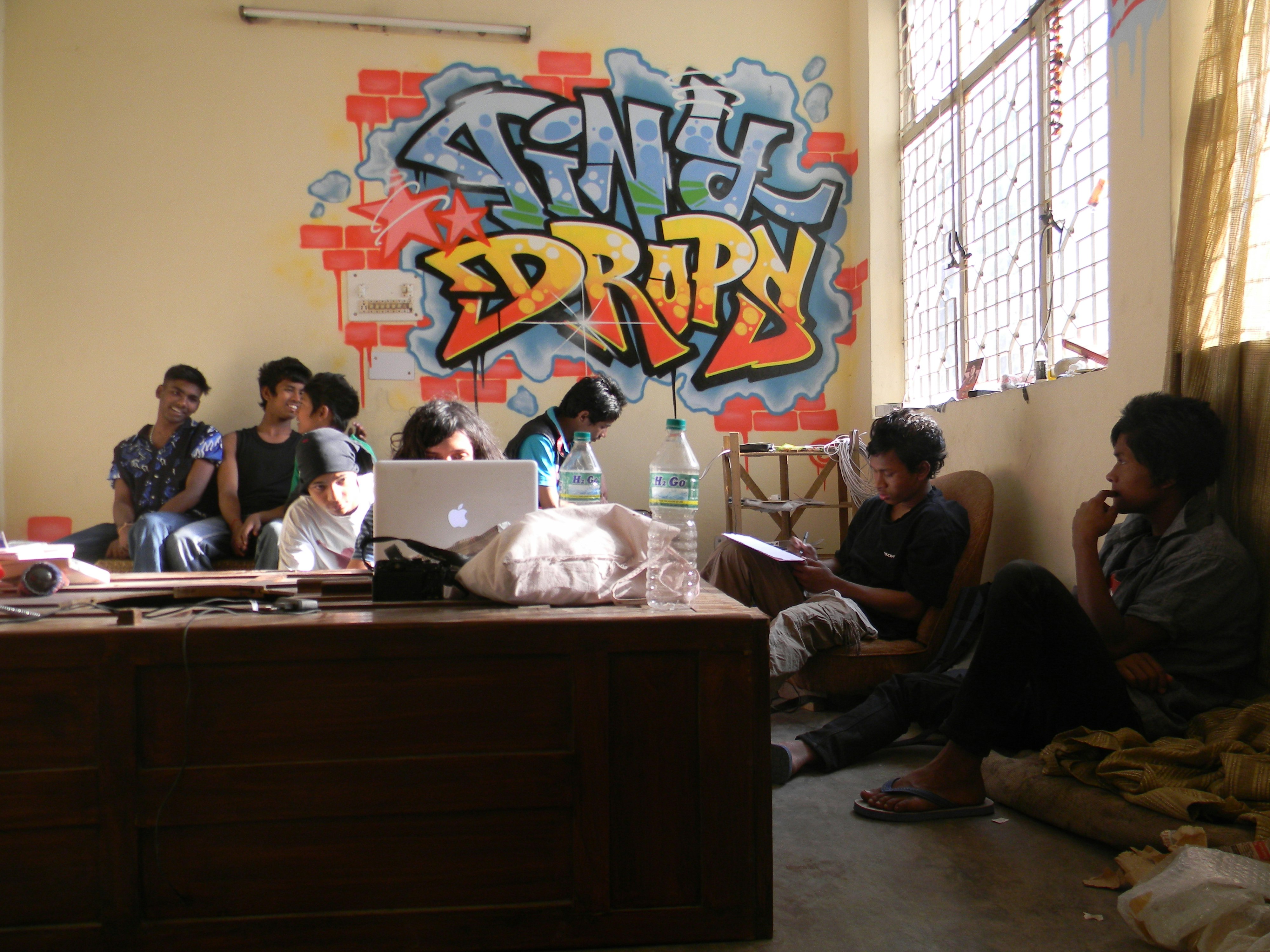
Extension Khirkee (Akshay, Rishi, Shiv & Needle) and associates in the Tiny Drops studio, Delhi, March 2012; photo: Aastha Chauhun.
Through the accessibility of cheap Chinese-made phones and the perpetual cycle of YouTube videos, hip hop has captured the imagination of India’s youth in a big way; B-boys and their moves can be seen in local parks across the country. After 9/11 and its ensuing paranoia, New Yorker B-boy He Ra moved to India and started Tiny Drops, a hip hop community centre. In 2010, He Ra opened a centre in Khirkee where schoolmates Akshay and Hari met Freezak alongside many other young, talented hip hop dancers and musicians. Tiny Drops describes itself as a ‘hip-hop community centre + artist collective representing B-boys, graffiti writers, MCs, DJs and other artists’. Functioning out of a flat in Khirkee, the Tiny Drops studio was He Ra and his partner Radhika’s home as well as a collaborative space for hip hop artists like Zine & Sam Sam, Wazulu da Ill Dravidian, Kru172 and DJ Karma. Tiny Drops was part of the wave that initiated the ‘Desi’ hip hop scene in the 2000s that continues to inspire youth across India. Akshay, Freezak and Hari were amongst the thirty or so kids who formed the Slumgods, a Delhi crew under the guidance and mentorship of He Ra and his talented friends. Although the Tiny Drops studio no longer exists in Khirkee, their collective energy continues to inspire youth in the neighbourhood.
When Tiny Drops gave up their Khirkee studio, the Slumgods had to find other places to jam. They were kicked out of local parks, metro stations, bus stops and sometimes even out of their own homes. Once, at the shopping mall that defines Khirkee’s southern fringe, there was a scuffle with the guards who mercilessly beat up Freezak and two friends on the pretext of disallowing ‘riffraff’ from sullying such an august establishment as a temple of commerce. Despite this trend, the crew, undeterred, moved on and found other options to continue their work, for instance at Malini Kochupillai’s house (artist, local resident, friend), Khoj studio, and more recently at the Korean Cultural Centre in nearby Lajpat Nagar.
In the span of a few years Slumgods, Delhi participated in several local projects, festivals and B-boy battles. For instance, during the religious festival of Durga Puja, the Bengali society of Malviya Nagar invited them to perform at their puja pandals. The local resident welfare association invited them to rap on the occasion of the nation’s Republic Day, where, Hari adds, people’s only reason for attendance is to watch them perform, patiently waiting through speeches and flag hoisting, until the Slumgods take the stage.
Often, local politicians approach them to perform at their rallies. Freezak had written a rap about the 2011 anti-corruption movement led by Anna Hazare, a non-violent Gandhian activist who was a prominent figure in instigating a series of non-violent demonstrations and protests that demanded action against the state political corruption. Freezak wrote, Anna hai aadmi badey he achhe, Anno ko support kartey hai bachhe, Anne ne na thi thi lathi uthai, bhrashtachar ke khilaf unne kee thi ladai. Roughly translated: ‘Anna is a good man / children support him / Anna did not raise any weapons / Anna fought against corruption’ —though of course the poetry of the words are lost in translation.

Flash mob, Khirkee, 2013; photo: Aastha Chauhan.
In 2012, Tiny Drops organised a B-boy battle for the Extension Khirkee Street Art Festival. This was a zero budget festival and all the participating musicians and artists participated pro bono. The following year, B-boy Akshay was working with me for Aapki Sadak, an urban design project that addressed the issues and challenges of alternative mobility and pedestrianisation within the neighbourhood. Akshay wrote a rap about democratisation of street access: ameer ke munde chalatey hai gaadi, gareeb ke mundey khaatey hai gale (‘sons of the rich drive cars / sons of the poor get abused’, roughly translated). He also choreographed a flash mob with local residents to this rap and performed it at a busy traffic junction.
Akshay was paid a part-time salary for this work by the Shakti Sustainable Energy Foundation. We deployed several creative tools, such as street art/stencilling, dance, theatre and social networking platforms like WordPress and Facebook, to generate public consensus for reclaiming parks from being used as car parks, encouraging public transport and ensuring safe last mile connectivity, as well as challenge the status quo of car ownership, public access to the streets and the urgent need to rethink our equation with the environment. The music, performance and ethos of hip hop played a big role in translating these complex, layered and interconnected propositions for alternative mobility in Khirkee, Malviya Nagar.
By 2014, Slumgods invited Hassan (a rapper of Somali descent) to perform his Hindi compositions for the Antarrashtriya Khirkee/International Khirkee Festival. The Indian audience at the festival were amused and extremely entertained to watch this young Somali boy rap in their language. The festival was organised against the unfortunate backdrop of racist attacks against the African migrants living in Khirkee. This block party included the multicultural cuisines available in Khirkee, live music performances by local artists, a photography exhibition, clown performance and film screenings organised at a local market complex. The participating artists were paid a modest honorarium for their performances. Contributions by artists and their friends, both cash and in-kind, made this festival possible. As this might signal, money received from performances is irregular and the platform provided by the institution or event is often considered remuneration enough. Just last week, a prominent multinational hotel chain offered Slumdogs, Delhi and myself a room and a meal at their hotel in Delhi in exchange for a performance. We politely declined the offer and requested a fee instead.
Slumdogs, Delhi later splintered and formed the Madness crew, more recently Survival crew. Other hip hop crews from South Delhi began to mushroom and as of today there are more than fifthteen crews in the district alone, namely Project Street Dance, Dance Mafia Crew, Khatarnak, Agnastik, Techi Kamaal, 8 Hindus, Pop Nation, Tandavas, Goodwill Crew, Power Engines, Celestials, (CDC) and Azad Crew.
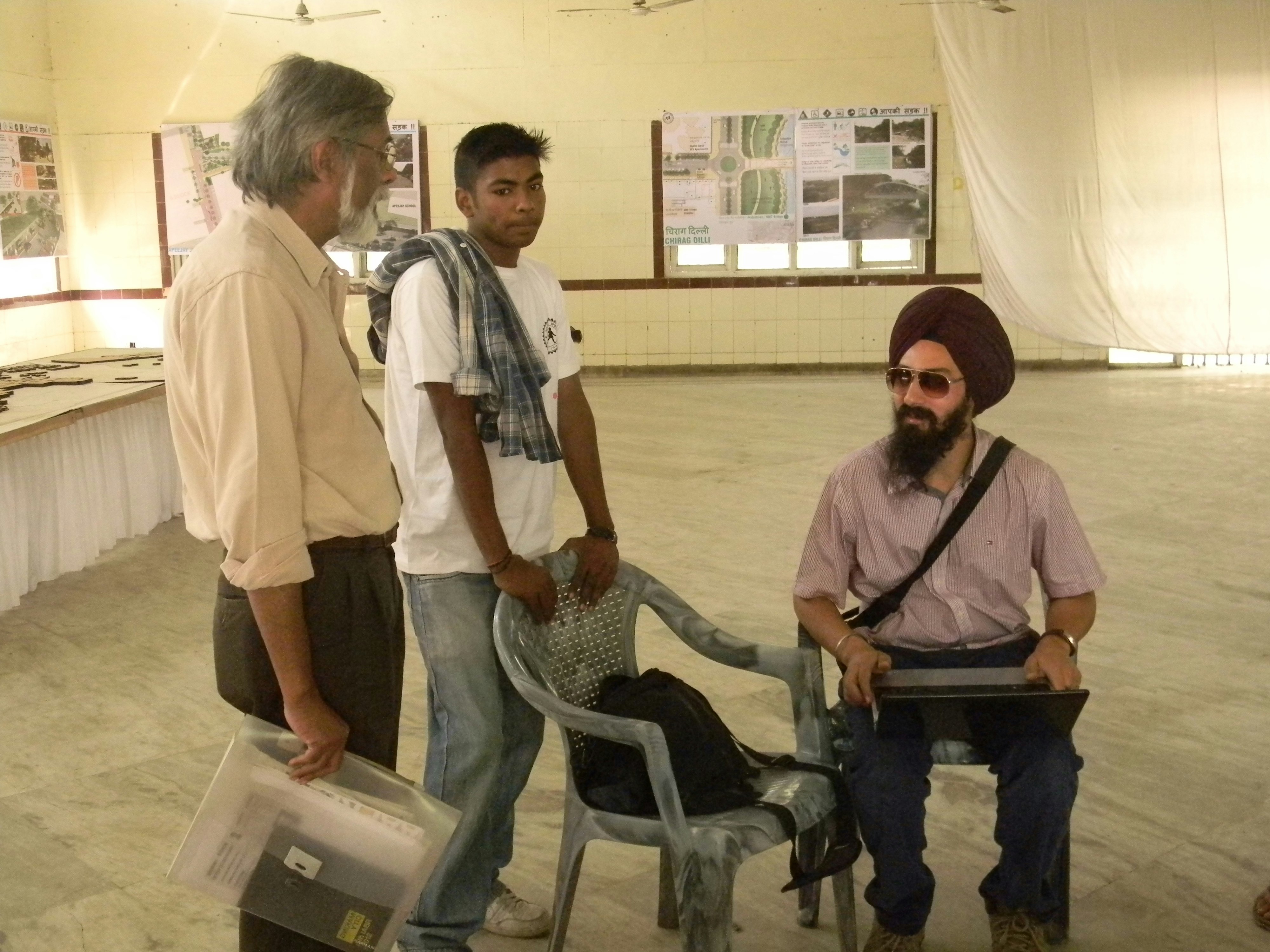
Akshay with architects Ashok Lal and Gurjot Singh, Aapki Sadak project, Delhi, April 2013; photo: Aastha Chauhun.
There seems to be an inaccurate perception, popular amongst the educated elite, that the production of art and culture is primarily the forte of people with privileges; all other sub-cultures and creative forms are somehow ‘lesser’ art. The agency, it is believed, lies with the artist who receives a grant to get a cursory understanding of such lesser art forms and reproduce them for consumption in galleries, museums and art fairs. While Slumgods, Delhi received a fair share of attention from artists, researchers, media and press, the tone and crux of enquiry was almost always voyeuristic— wanting to peep into their homes, to get a sense of their economic condition in order to fulfil a predetermined rags to riches narrative that most often conceals rather than reveals the very real obstacles encountered by the young people of Khirkee towards economic advancement, particularly within a cultural economy that privileges ‘exposure’ over a pay cheque. Akshay, Hari, Shiv, Freezak and He Ra were very upset when an English artist, who wanted to make a video about the B-boys of Khirkee, included footage of private conversations and the interiors of their homes in this film, despite their request not to. For the boys, references to class differences are often part of their poetry, and there is never any pretence or shame. There was something about bringing a white man home so he could record their circumstances and then screen it to a rich gallery/museum audience didn’t sit well for them. The fact that this artist was unwilling to share the password for the video’s upload on YouTube , in addition to the fact that they were turned away from the venue where this was being screened, added insult to injury. In the end, He Ra had to fight for INR 4,000 (about AU$80) as a modest fee for each of the protagonists of this artist’s film.
By the time Akshay and Hari were graduating from high school in 2014, Slumgods, Delhi was already a well known crew in the neighbourhood and their clothes and swagger were being imitated by the younger boys and girls from the locale. Their guest appearance in a Bollywood film, One by Two, added to their celebrity. And yet with this important milestone of finishing their secondary education came other issues. While Freezak’s family is supportive of his talent and interest in hip hop, Akshay and Hari’s families were beginning to worry about their future job prospects. Akshay was working part-time as a wedding horse caretaker and Freezak and Hari took up odd jobs with event management companies. Unable to find the time to write music and practice their dance, the boys were thinking about business ideas that they could integrate with their art form.
A conversation between myself and Akshay in the summer of 2014 led to the idea of establishing our own hip-hop fashion and accessories retail business. Akshay, Hari, Freezak and I spent almost two years discussing myriad possibilities and plans, seeking advice from our friends who are experts in the fields of music, fashion, and advertising. The hope was to get the idea off the ground and gradually bring our other partners from Slumgods, Delhi on board. After much deliberation the name {Khirkee17} was chosen for the enterprise, with ‘17’ being the postal code. We spoke to Hemant Sreekumar, an ex-colleague of mine from KHOJ, data visualiser and sound artist, who was familiar with Tiny Drops’ work since its inception. As someone who is currently working with a prominent media and advertising house, our first question to Hemant was, is this a feasible business plan? Hemant suggested we narrow it down to selling just t-shirts and introduce a few other products as we go along.
Initially, we focused on local consumers in Khirkee, using our home ground advantage. The younger kids from Khirkee were already imitating the styles these boys were introducing: funky, coloured hair that defies gravity; chains and other accessories pinned to back packs and trousers; caps and hand-painted shoes that were customised to taste. We imagined hiring an apartment where we could produce some of the products as well as source some basics from various markets like Gafar and Sarojini where the boys were shopping. When we calculated the costs of hiring a flat (at a discounted rent from a local patron), including basic infrastructure and raw material for the shop, we realised that this format required a seed grant from an institute, or we could crowd fund our experiment. Hemant offered to help us put together a crowd funding campaign. This idea did not materialise as expected. Given our individual commitments and priorities, it was difficult to find the time to see this through. Additionally, Hari’s brother’s arrest and Akshay getting ripped off on a fraudulent laptop deal on OLX did not expedite the process. Although the crowd funding idea slipped away, on Hemant’s suggestion a new rap was written, composed and recorded. Brin Desai (ex-Khirkee resident, sound engineer and musician) recorded and mixed the track for the boys, with He Ra covering the studio costs. Martin V, Hemant’s colleague at the media house, offered to make a video for the track. The video will be launched later this year, to coincide with a T-shirt sale/performance by {Khirkee 17}.

{Khirkee17} screen printing with Yemi Awosile, Delhi, March 2016; photo: Aastha Chauhun.
Towards the end of 2014, I met Yemi Awosile, a multi-disciplinary designer from London, who offered to help us. It took us two years to organise her visit to Delhi, and in April 2016 Yemi arrived in Khirkee to teach us the basics of screen-printing. After an extensive and exciting workshop led by Yemi, {Khirkee17} officially launched its range of t-shirts at an event organised by our friends and reggae musicians Delhi Sultanate and Begum X (aka Samara Chopra). Soon after the launch, {Khirkee17} was commissioned by Foxity, a mobile phone social nightlife and networking app owned and managed by two Mexican entrepreneurs living in Delhi, to make t-shirts for their corporate party. Javier Altamirano Miranda, Foxity’s chief marketing officer, read about us in some online article and contacted us through Facebook. This was our first commission and despite a few glitches we were able to complete the order on time.
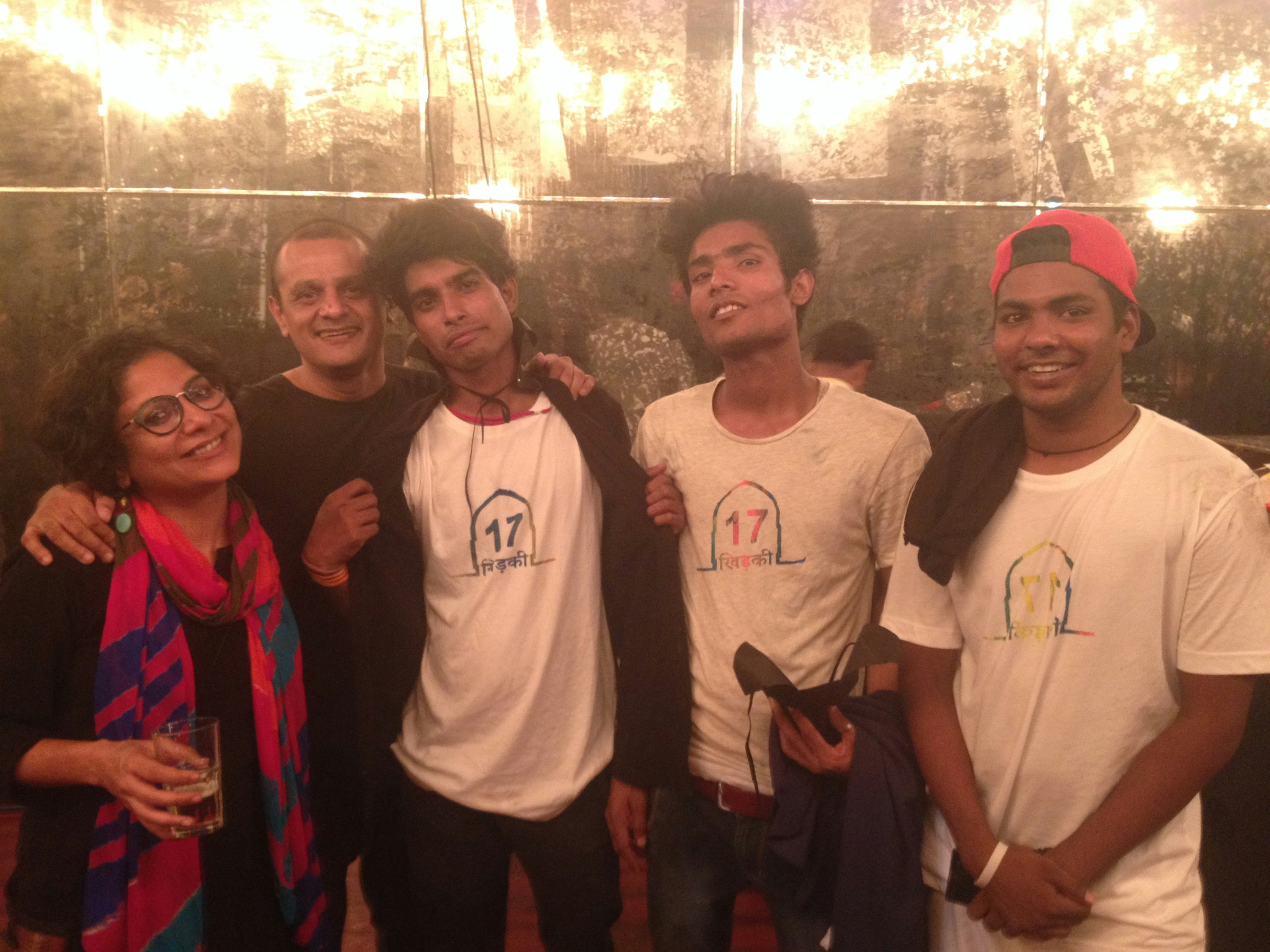
{Khirkee17} at the Foxity launch (left to right: Aastha Chauhun, Brin, Hari, Freezak & Akshay), Delhi, September 2016; photo: Aditya Narula.
{Khirkee17} was on a roll with another commission from a private museum housed in a shopping mall across the street, the Kiran Nadar Museum of Art (KNMA). We were invited to design and print 250 t-shirts inspired by the artworks of the ongoing retrospectives of four modernist Indian artists: Jeram Patel, KG Subramanyan, Himmat Shah and Nasreen Mohamedi. Rarely frequented by the residents from across the street, the museum saw this as an outreach project as well a commission for their shop. New to the world of museums and modernism in Indian art, MC Freezak, MC Akshay and collaborators Kumar and Hari Singh spent long hours in the museum making drawings, writing rap about Indian modernism and forming connections (formal and conceptual) with these masters. The questions we raised at the beginning of the process were, Does Desi hip hop and modernism in Indian art have anything in common? Is there any possibility of a conversation between these two expressions of social realities? Initially I was not sure if there were any relevant overlaps or even an interesting arena of interface. I am happy to admit that I was wrong. For five months we were paid INR 10,000 each, per month, for our work, reserving INR 2,000 per person, per month, towards a common pool for {Khirkee17}. Although remittance from the museum was late, this became a n important source of income and an invaluable learning experience for us.
During our time at the museum, {Khirkee17} began taking people on walks around the neighbourhood. First introduced at the Delhi Walk Festival, the walking trail designed by {Khirkee17} begins at a fourteenth-century dam and makes its way through the equally old and spectacular remains of Khirkee Masjid before meandering through the GATI contemporary dance studio, the galleries at KHOJ, culminating at the Kiran Nadar Museum of Art. Once there, {Khirkee17} rap about modernism, its member B-boys speak about their (refreshing) interpretations of the artworks on display and the process of unpacking modernism in Indian art by way of translating it onto t-shirts.
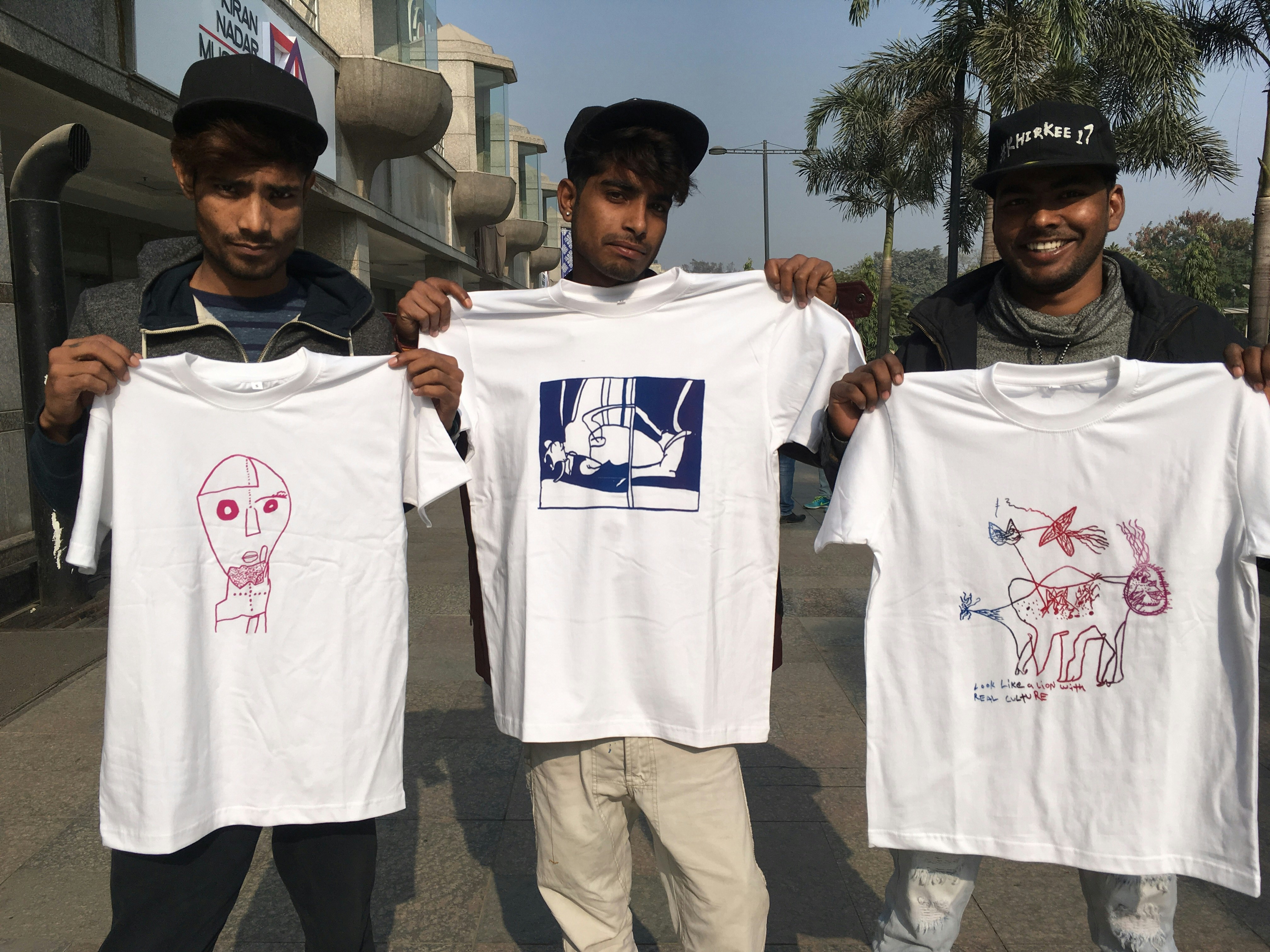
{Khirkee17} outside the Kiran Nadar Museum of Art (KNMA) with their recent creations following a KNMA commission, December 2106; photo: Aastha Chauhun.
Although the museum provided us with catalogues and other reference books and introductions to these artworks, it is the reading and personal interpretations of the works that make the {Khirkee17} museum tour unique. The personal histories from playing hide and seek at the mosque as kids, to lived memories of this ‘hood, make this walk more than a historical tour and fact-finding mission. The Hindu families living around the Khirkee mosque believe that it is a fort built by a twelfth-century Hindu king, Prithviraj Chauhan. As history gets rewritten in contemporary India, under the right wing nationalist wave, this walk is yet another rendering of history, memory, belief, fact and fiction.
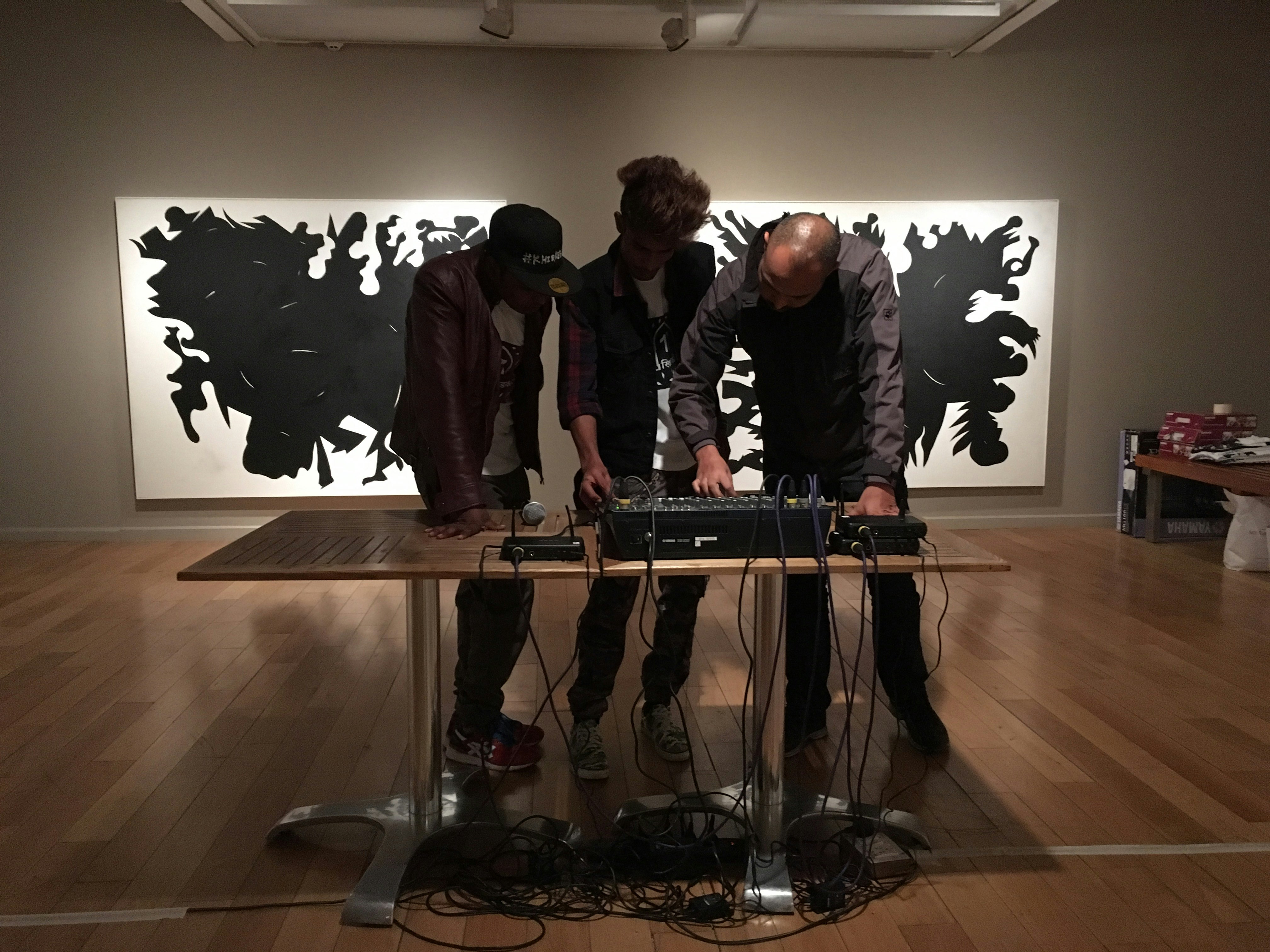
Last minute sound check, {Khirkee17} with Hemant Sreekumar, Kiran Nadar Museum of Art, Delhi, December 2016; photo: Aastha Chauhun.
Toward the end of our commission at KNMA we invited Khatarnak and Survival crews to perform with {Khirkee17} inside the museum. Survival crew, a break away association of hip hoppers from Slumgods, comprises B-boy Shiv, B-boy Khem, B-boy Brijesh and B-boy Mac. Shiv has won several awards for his Power moves, and his Instagram account is one of the most popular amongst his peers. Shiv admits that he feels shy and awkward asking for a fee for this performances. He tell me, ‘Despite the heat, irregular income and lack of support, the love I get from the people is worth every bit of it.’ The event at KNMA was well attended by our friends and families. Against the backdrop of Jeram Patel’s modernist canvases, the performances were riveting, and as Akshay puts it, thande museum mei aag laga di. Roughly translated: ‘we set the cold museum on fire’.
We are currently working on our next event, a video launch, t-shirt sale and live performance to be held at KHOJ. Freezak is clear about what he expects from {Khirkee17}: ‘no big cars or big life, just enough to get by.’ The idea is to avoid taking grants, either form corporate social responsibility avenues or from art institutions, and instead enjoy working with friends and supporters, to hopefully find a balance between sustainability and independence.
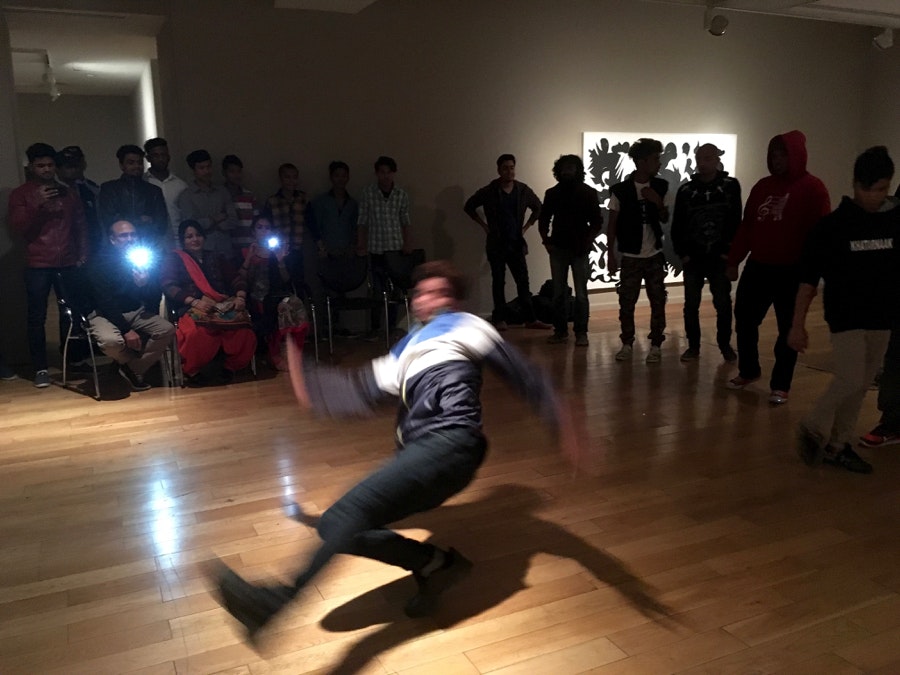
{Khirkee17} with Survival and Khatarnak crews performing at Kiran Nadar Museum of Art (KNMA), December 2016; photo: Kush Sethi.
About the contributor
Aastha Chauhan was born in Ajmer, Rajasthan in 1981. She studied sculpture at the Panjab and later Delhi University. Chauhan’s art practise can be defined as public, socially engaged and site specific.
